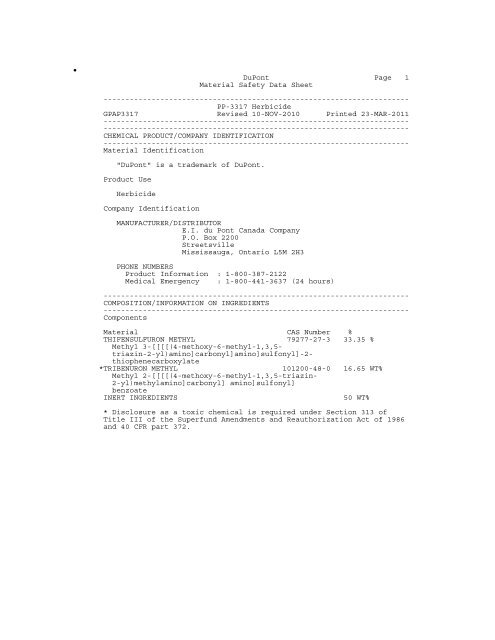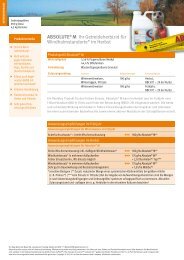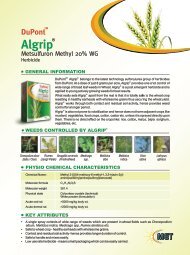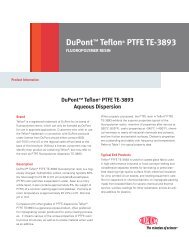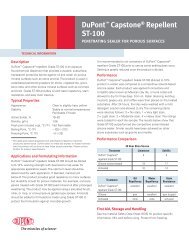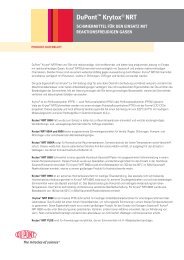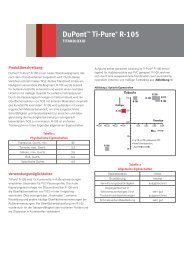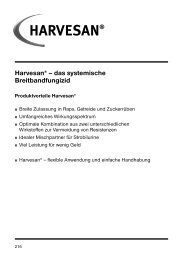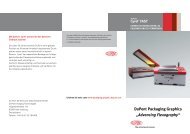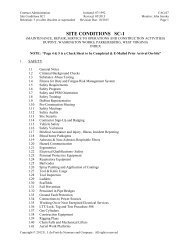3317 MSDS (PDF) - DuPont
3317 MSDS (PDF) - DuPont
3317 MSDS (PDF) - DuPont
Create successful ePaper yourself
Turn your PDF publications into a flip-book with our unique Google optimized e-Paper software.
•<br />
<strong>DuPont</strong> Page 1<br />
Material Safety Data Sheet<br />
----------------------------------------------------------------------<br />
PP-<strong>3317</strong> Herbicide<br />
GPAP<strong>3317</strong> Revised 10-NOV-2010 Printed 23-MAR-2011<br />
----------------------------------------------------------------------<br />
----------------------------------------------------------------------<br />
CHEMICAL PRODUCT/COMPANY IDENTIFICATION<br />
----------------------------------------------------------------------<br />
Material Identification<br />
"<strong>DuPont</strong>" is a trademark of <strong>DuPont</strong>.<br />
Product Use<br />
Herbicide<br />
Company Identification<br />
MANUFACTURER/DISTRIBUTOR<br />
E.I. du Pont Canada Company<br />
P.O. Box 2200<br />
Streetsville<br />
Mississauga, Ontario L5M 2H3<br />
PHONE NUMBERS<br />
Product Information : 1-800-387-2122<br />
Medical Emergency : 1-800-441-3637 (24 hours)<br />
----------------------------------------------------------------------<br />
COMPOSITION/INFORMATION ON INGREDIENTS<br />
----------------------------------------------------------------------<br />
Components<br />
Material CAS Number %<br />
THIFENSULFURON METHYL 79277-27-3 33.35 %<br />
Methyl 3-[[[[(4-methoxy-6-methyl-1,3,5-<br />
triazin-2-yl)amino]carbonyl]amino]sulfonyl]-2-<br />
thiophenecarboxylate<br />
*TRIBENURON METHYL 101200-48-0 16.65 WT%<br />
Methyl 2-[[[[(4-methoxy-6-methyl-1,3,5-triazin-<br />
2-yl)methylamino]carbonyl] amino]sulfonyl]<br />
benzoate<br />
INERT INGREDIENTS 50 WT%<br />
* Disclosure as a toxic chemical is required under Section 313 of<br />
Title III of the Superfund Amendments and Reauthorization Act of 1986<br />
and 40 CFR part 372.
GPAP<strong>3317</strong> <strong>DuPont</strong> Page 2<br />
Material Safety Data Sheet<br />
----------------------------------------------------------------------<br />
HAZARDS IDENTIFICATION<br />
----------------------------------------------------------------------<br />
Emergency Overview<br />
Caution! Avoid contact with eyes, skin, or clothing.<br />
Prolonged or frequently repeated skin contact may cause<br />
allergic reactions in some individuals. Wash thoroughly with<br />
soap and water after handling.<br />
For medical emergencies involving this product, call toll-<br />
free 1-800-441-3637.<br />
Potential Health Effects<br />
Based on animal data, skin contact may cause skin irritation with<br />
discomfort or rash and skin sensitization with allergic rashes.<br />
Based on animal data, eye contact may cause eye irritation with<br />
discomfort, tearing, or blurring of vision.<br />
Based on animal data, inhalation may cause irritation of the upper<br />
respiratory tract, with coughing and discomfort.<br />
Carcinogenicity Information<br />
None of the components present in this material at concentrations<br />
equal to or greater than 0.1% are listed by IARC, NTP, OSHA or ACGIH<br />
as a carcinogen.<br />
----------------------------------------------------------------------<br />
FIRST AID MEASURES<br />
----------------------------------------------------------------------<br />
First Aid<br />
IF ON SKIN OR CLOTHING: Take off contaminated clothing.<br />
Rinse skin immediately with plenty of water for 15-20<br />
minutes. Call a poison control center or doctor for<br />
treatment advice.<br />
IF IN EYES: No specific intervention is indicated, as the<br />
product is not likely to be hazardous to the eyes. Consult<br />
physician if necessary.<br />
IF INHALED: No specific intervention is indicated, as the<br />
product is not likely to be hazardous by inhalation.<br />
Consult a physician if necessary.<br />
IF SWALLOWED: No specific intervention is indicated, as the<br />
product is not likely to be hazardous by ingestion.<br />
Consult a physician if necessary.<br />
Have the product container or label with you when calling a<br />
poison control center or doctor, or going for treatment.<br />
You may also contact 1-800-441-3637 for emergency medical
GPAP<strong>3317</strong> <strong>DuPont</strong> Page 3<br />
Material Safety Data Sheet<br />
treatment information.<br />
(FIRST AID MEASURES - Continued)<br />
----------------------------------------------------------------------<br />
FIRE FIGHTING MEASURES<br />
----------------------------------------------------------------------<br />
Flammable Properties<br />
Not a fire or explosion hazard.<br />
LEL is 0.1 - 0.25 g/L<br />
Minimum ignition energy is >1 joules<br />
Like most organic powders or crystals, under severe dusting<br />
conditions, this material may form explosive mixtures in air.<br />
Extinguishing Media<br />
Water Spray, Foam, Dry Chemical, CO2.<br />
Fire Fighting Instructions<br />
Evacuate personnel to a safe area. Keep personnel removed and<br />
upwind of fire. Wear self-contained breathing apparatus. Wear<br />
full protective equipment. Runoff from fire control may be a<br />
pollution hazard.<br />
If area is heavily exposed to fire and if conditions permit,<br />
let fire burn itself out since water may increase the<br />
contamination hazard.<br />
----------------------------------------------------------------------<br />
ACCIDENTAL RELEASE MEASURES<br />
----------------------------------------------------------------------<br />
Safeguards (Personnel)<br />
NOTE: Review FIRE FIGHTING MEASURES and HANDLING (PERSONNEL)<br />
sections before proceeding with clean-up. Use appropriate<br />
PERSONAL PROTECTIVE EQUIPMENT during clean-up.<br />
Spill Clean Up<br />
Shovel or sweep up.<br />
----------------------------------------------------------------------<br />
HANDLING AND STORAGE<br />
----------------------------------------------------------------------<br />
Handling (Personnel)<br />
USERS SHOULD: Wash hands before eating, drinking, chewing<br />
gum, using tobacco or using the toilet. Remove clothing<br />
immediately if pesticide gets inside. Then wash thoroughly<br />
and put on clean clothing. Remove PPE immediately after<br />
handling this product. Wash the outside of gloves before<br />
removing. As soon as possible, wash thoroughly and change
GPAP<strong>3317</strong> <strong>DuPont</strong> Page 4<br />
Material Safety Data Sheet<br />
into clean clothing.<br />
Handling (Physical Aspects)<br />
Avoid dust generation.<br />
Storage<br />
(HANDLING AND STORAGE - Continued)<br />
Store product in original container only. Do not<br />
contaminate water, other pesticides, fertilizer, food or<br />
feed in storage. Store in a cool, dry place.<br />
----------------------------------------------------------------------<br />
EXPOSURE CONTROLS/PERSONAL PROTECTION<br />
----------------------------------------------------------------------<br />
Engineering Controls<br />
When handlers use closed systems, enclosed cabs, or<br />
aircraft in a manner that meets the requirements listed in<br />
the Worker Protection Standard (WPS) for agricultural<br />
pesticides [40 CFR 170.240 (d)(4-6)], the handler PPE<br />
requirements may be reduced or modified as specified in the<br />
WPS.<br />
Important: When reduced PPE is worn because a closed system<br />
is being used, handlers must be provided all PPE specified<br />
above for "Applicators and Other Handlers" and have such PPE<br />
immediately available for use in an emergency, such as a<br />
spill or equipment breakdown.<br />
Personal Protective Equipment<br />
Some of the materials that are chemical-resistant to this<br />
product are listed below. If you want more options, follow<br />
the instructions for Category A on an EPA chemical-<br />
resistance category selection chart.<br />
Applicators and other handlers must wear:<br />
Long-sleeved shirt and long pants.<br />
Chemical-Resistant gloves made of any waterproof<br />
material such as polyethylene or polyvinyl<br />
chloride.<br />
Shoes plus socks.<br />
Follow manufacturer's instructions for cleaning/maintaining<br />
PPE. If no such instructions for washables, use detergent<br />
and hot water. Keep and wash PPE separately from other<br />
laundry.<br />
PPE required for early entry to treated areas that is<br />
permitted under the Worker Protection Standard and that<br />
involves contact with anything that has been treated, such<br />
as plants, soil, or water, is:
GPAP<strong>3317</strong> <strong>DuPont</strong> Page 5<br />
Material Safety Data Sheet<br />
(EXPOSURE CONTROLS/PERSONAL PROTECTION - Continued)<br />
Coveralls.<br />
Chemical-Resistant gloves made of any waterproof<br />
material.<br />
Shoes plus socks.<br />
Exposure Guidelines<br />
Applicable Exposure Limits<br />
THIFENSULFURON METHYL<br />
PEL (OSHA) : None Established<br />
TLV (ACGIH) : None Established<br />
AEL * (<strong>DuPont</strong>) : 5 mg/m3, 8 & 12 Hr. TWA<br />
TRIBENURON METHYL<br />
PEL (OSHA) : None Established<br />
TLV (ACGIH) : None Established<br />
AEL * (<strong>DuPont</strong>) : 1 mg/m3, 8 Hr. TWA<br />
* AEL is <strong>DuPont</strong>'s Acceptable Exposure Limit. Where governmentally<br />
imposed occupational exposure limits which are lower than the AEL<br />
are in effect, such limits shall take precedence.<br />
----------------------------------------------------------------------<br />
PHYSICAL AND CHEMICAL PROPERTIES<br />
----------------------------------------------------------------------<br />
Physical Data<br />
pH : 8.2 - 9.5 (1% aqueous solution)<br />
Odor : Slight<br />
Form : Granule<br />
Color : Tan<br />
----------------------------------------------------------------------<br />
STABILITY AND REACTIVITY<br />
----------------------------------------------------------------------<br />
Chemical Stability<br />
Stable at normal temperatures and storage conditions.<br />
Incompatibility with Other Materials<br />
None reasonably foreseeable.<br />
Decomposition<br />
Decomposition will not occur.<br />
Polymerization<br />
Polymerization will not occur.
GPAP<strong>3317</strong> <strong>DuPont</strong> Page 6<br />
Material Safety Data Sheet<br />
----------------------------------------------------------------------<br />
TOXICOLOGICAL INFORMATION<br />
----------------------------------------------------------------------<br />
Animal Data<br />
Thifensulfuron Methyl 50SG<br />
Oral LD50: > 5000 mg/kg in rats<br />
Dermal LD50: > 5000 mg/kg in rats<br />
4-Hour Inhalation LC50: > 7.9 mg/L in rats<br />
(technical material)<br />
Thifensulfuron Methyl 50SG is not a skin or eye irritant nor a<br />
skin sensitizer in animals.<br />
Tribenuron Methyl 50SG<br />
Oral LD50: > 5000 mg/kg in rats<br />
Dermal LD50: > 5000 mg/kg in rats<br />
4-Hour Inhalation LC50: > 6.0 mg/L in rats<br />
(technical material)<br />
Tribenuron Methyl 50SG is not a skin or eye irritant in animals,<br />
but is a skin sensitizer in animals.<br />
The effects in animals from a single ingestion exposure include<br />
hyperreactivity and tremors.<br />
THIFENSULFURON METHYL<br />
The effects in animals from short inhalation exposure to<br />
Thifensulfuron Methyl include nonspecific effects such as weight<br />
loss, and irritation when compared to the control group.<br />
Repeated ingestion exposures to Thifensulfuron Methyl caused<br />
decreased body and organ weights, and some blood chemistry<br />
changes, including increased blood urea nitrogen and decreased<br />
protein and globulins. Long-term exposures caused an increase in<br />
liver weights, decreased body weight gain, and a decreased level<br />
of sodium in the blood when compared to the control group.<br />
No carcinogenic effects were observed in animal tests with<br />
Thifensulfuron Methyl. Animal data show developmental effects<br />
only at exposure levels producing toxic effects in the adult<br />
animal. Tests in animals demonstrate no reproductive toxicity.<br />
Thifensulfuron Methyl does not produce genetic damage in bacterial<br />
or mammalian cell cultures or animals.<br />
TRIBENURON METHYL<br />
Repeated ingestion of high doses of Tribenuron Methyl caused body<br />
weight loss, increased liver and thyroid/parathyroid weights,<br />
altered clinical chemical parameters, but no significant gross or<br />
microscopic treatment related effects were noted. Long-term<br />
dosing caused body weight loss, alteration in clinical chemical<br />
parameters, and testicular atrophy (considered to be biologically<br />
insignificant).
GPAP<strong>3317</strong> <strong>DuPont</strong> Page 7<br />
Material Safety Data Sheet<br />
(TOXICOLOGICAL INFORMATION - Continued)<br />
Tribenuron Methyl produced an increased incidence of mammary<br />
tumors in female rats at dose levels also producing other<br />
significant effects. Developmental effects occurred in the rat,<br />
but only at a dose also toxic to the dam. No reproductive effects<br />
were observed in rats. Tribenuron Methyl did not produce genetic<br />
damage in bacterial or mammalian cell cultures or in animals.<br />
----------------------------------------------------------------------<br />
ECOLOGICAL INFORMATION<br />
----------------------------------------------------------------------<br />
Ecotoxicological Information<br />
AQUATIC TOXICITY:<br />
THIFENSULFURON METHYL<br />
96 hour LC50 - Rainbow trout: > 100 mg/L.<br />
96 hour LC50 - Bluegill sunfish: > 100 mg/L.<br />
96 hour EC50 - Freshwater algae: 0.840 - 1.03 mg/L.<br />
AVIAN TOXICITY:<br />
Acute Oral LD50 - Mallard Duck: > 2510 mg/kg.<br />
Acute Dietary LC50 - Mallard Duck: > 5620 mg/kg.<br />
Acute Dietary LC50 - Bobwhite Quail: > 5620 mg/kg.<br />
AQUATIC TOXICITY:<br />
TRIBENURON METHYL<br />
96 hour LC50 - Rainbow trout: > 1000 mg/L.<br />
120 hour, EC50, Freshwater algae: 2.6 - 13.1 mg/L.<br />
AVIAN TOXICITY:<br />
Acute Oral LD50 - Bobwhite Quail: > 2250 mg/kg.<br />
Acute Dietary LC50 - Bobwhite Quail: > 5620 ppm.<br />
Acute Dietary LC50 - Mallard Duck: > 5620 ppm<br />
----------------------------------------------------------------------<br />
DISPOSAL CONSIDERATIONS<br />
----------------------------------------------------------------------<br />
Waste Disposal<br />
Do not contaminate water, food, or feed by disposal. Waste<br />
resulting from the use of this product may be disposed of on<br />
site or at an approved waste disposal facility.<br />
ENVIRONMENTAL HAZARDS<br />
Do not apply directly to water, or to areas where surface<br />
water is present, or to intertidal areas below the mean high<br />
water mark. Do not contaminate water when cleaning<br />
equipment or disposing of equipment washwaters. Do not<br />
apply where/when conditions favor runoff.
GPAP<strong>3317</strong> <strong>DuPont</strong> Page 8<br />
Material Safety Data Sheet<br />
Container Disposal<br />
(DISPOSAL CONSIDERATIONS - Continued)<br />
For Plastic Containers: Triple rinse (or equivalent). Then<br />
offer for recycling or reconditioning, or puncture and<br />
dispose of in a sanitary landfill, or incineration, or, if<br />
allowed by State and local authorities, by burning. If<br />
burned, stay out of smoke.<br />
For Fiber Sacks: Completely empty fiber sack by shaking and<br />
tapping sides and bottom to loosen clinging particles.<br />
Empty residue into manufacturing or application equipment.<br />
Then dispose of sack in a sanitary landfill or by<br />
incineration if allowed by State and local authorities.<br />
For Fiber Drums with Liners: Completely empty liner by<br />
shaking and tapping sides and bottom to loosen clinging<br />
particles. Empty residue into application equipment. Then<br />
dispose of liner in a sanitary landfill or by incineration<br />
if allowed by State and local authorities. If drum is<br />
contaminated and cannot be reused, dispose of in the same<br />
manner.<br />
For Bags Containing Water-Soluble Packets: Do not reuse the<br />
outer box or the re-sealable plastic bag. When all water-<br />
soluble packets are used, the outer packaging should be<br />
clean and may be disposed of in a sanitary landfill or by<br />
incineration, or if allowed by State and local authorities,<br />
by open burning. If burned, stay out of smoke. If the<br />
resealable plastic bag contacts the formulated product in<br />
any way, the bag must be triple rinsed with clean water.<br />
Add the rinsate to the spray tank and dispose of the outer<br />
wrap as described above.<br />
For Metal Containers (non aerosol): Triple rinse (or<br />
equivalent) the container. Then offer for recycling or<br />
reconditioning, or puncture and dispose of in a sanitary<br />
landfill, or by other procedures approved by State and local<br />
authorities.<br />
For Paper and Plastic Bags: Completely empty bag into<br />
application equipment. Then dispose of empty bag in a<br />
sanitary landfill or by incineration, or, if allowed by<br />
State and local authorities, by burning. If burned, stay out<br />
of smoke.
GPAP<strong>3317</strong> <strong>DuPont</strong> Page 9<br />
Material Safety Data Sheet<br />
----------------------------------------------------------------------<br />
TRANSPORTATION INFORMATION<br />
----------------------------------------------------------------------<br />
Shipping Information<br />
DOT<br />
Proper Shipping Name : NOT REGULATED BY D.O.T.<br />
DOT/IMO<br />
Proper Shipping Name : NOT REGULATED<br />
Shipping Information -- Canada<br />
This material is Not Regulated.<br />
----------------------------------------------------------------------<br />
REGULATORY INFORMATION<br />
----------------------------------------------------------------------<br />
U.S. Federal Regulations<br />
TITLE III HAZARD CLASSIFICATIONS SECTIONS 311, 312<br />
Acute : Yes<br />
Chronic : No<br />
Fire : No<br />
Reactivity : No<br />
Pressure : No<br />
EPA Reg. No. 352-641<br />
Canadian Regulations<br />
Regulated under the Pest Control Products Act--WHMIS Exempt<br />
Registration No. 29927 Pest Control Products Act<br />
This product has been classified in accordance with the hazard<br />
criteria of the CPR and the <strong>MSDS</strong> contains all the information<br />
required by the CPR.<br />
----------------------------------------------------------------------<br />
OTHER INFORMATION<br />
----------------------------------------------------------------------<br />
NFPA, NPCA-HMIS<br />
NFPA Rating<br />
Health : 1<br />
Flammability : 1<br />
Reactivity : 0<br />
NPCA-HMIS Rating<br />
Health : 1<br />
Flammability : 1<br />
Reactivity : 0
GPAP<strong>3317</strong> <strong>DuPont</strong> Page 10<br />
Material Safety Data Sheet<br />
(Continued)<br />
Personal Protection rating to be supplied by user depending on use<br />
conditions.<br />
----------------------------------------------------------------------<br />
The data in this Material Safety Data Sheet relates only to the<br />
specific material designated herein and does not relate to use in<br />
combination with any other material or in any process.<br />
Responsibility for <strong>MSDS</strong><br />
----------------------- Crop Protection E.I. du Pont Canada Company<br />
Box 2200, Streetsville<br />
Mississauga, Ontario L5M 2H3<br />
(905) 821-3300.<br />
End of <strong>MSDS</strong>


